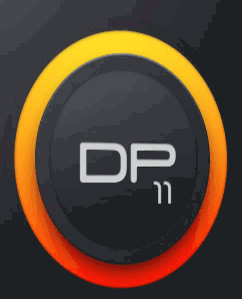Best Audio Editing Software
Finding the best Audio Editing Software for your business is now faster and easier! Compare prices, reviews, features, and get a free consultation to find the perfect software.



No Cost Personal Advisor
List of 20 Best Audio Editing Software
Emergents | 2024
Software by Global Delight Technologies Private Limited
Boom 3D, available for both Mac and Windows, stands as an acclaimed professional audio enhancement application. Crafted to elevate your media experience, it brings forth remarkable 3D effects regardless of the headphones you use or the media player and streaming services you prefer. Learn more about Boom 3D
Explore various Boom 3D features, compare the pricing plans, and unlock the potential of seamless operations by selecting the right software for your business.
Features
View all Boom 3D Features- Audio Restoration
- Noise Reduction and Removal
- Audio Transcription
- Voice-over and Narration
- Bookmark
- Export / Import
- Import and Export Audio Files
- Sound Quality
Pricing
Boom 3D Caters to
- StartUps
- SMBs
- Agencies
- Enterprises
Contenders | 2024
Software by Audacity
For users who are looking for an easy-to-use, multi-track audio editing and recording software for Windows, Audacity is the perfect fit. This free and open-source software offers easy audio editing, including cutting, copying, pasting, and deleting. Thanks to this fantastic audio editing software, you can easily edit and merge with several keyboard shortcuts. Read Audacity Reviews
Explore various Audacity features, compare the pricing plans, and unlock the potential of seamless operations by selecting the right software for your business.
Audacity Caters to
- StartUps
- SMBs
- Agencies
- Enterprises
Emergents | 2024
Software by Adobe
Rendered by Adobe, Audition is one of the best audio editing software in the market today. Rendered by Adobe, Audition is one of the best audio editing software on the market today. Users can mix, edit, and recover audio content using the multitrack, waveform, and spectral displays included in its extensive suite of audio editing capabilities. Learn more about Adobe Audition
Explore various Adobe Audition features, compare the pricing plans, and unlock the potential of seamless operations by selecting the right software for your business.
Features
View all Adobe Audition Features- Payment Processing
- Publishing / Sharing
- Member Portal
- Recording
- Application Management
- Drag & Drop
- Promotions Management
- Communication Management
Adobe Audition Caters to
- StartUps
- SMBs
- Agencies
- Enterprises
Emergents | 2024
Software by NCH Software, Inc
Wavepad is a fully-featured professional software with an audio editing program suitable for Windows and Mac. It offers audio editing tools like cut, copy, split, join, trim, etc., along with noise removal for audio restoration. Wavepad is usually used to edit Wav or MP3 files, but it also supports a number of other file types, such as VOX, GSM, WMA, real audio, AU, AIF, FLAC, and OGG. Learn more about WavePad
Explore various WavePad features, compare the pricing plans, and unlock the potential of seamless operations by selecting the right software for your business.
Features
View all WavePad Features- Reporting & Statistics
- Video Support
- Audio Recording
- Email Marketing
- Member Portal
- Data Import/Export
- Audience Analytics
- Publishing / Sharing
WavePad Caters to
- StartUps
- SMBs
- Agencies
- Enterprises
Emergents | 2024
Software by Cockos Incorporated
Reaper is a complete digital audio production and audio editing software for PC. With this astounding production toolset, you can efficiently record, edit, process, mix, and master full multitrack audio or MIDI. Supporting various hardware, digital formats, and plugins, it allows you to edit audio for commercial and home studios, broadcast, game development, etc. Learn more about Cockos Reaper
Explore various Cockos Reaper features, compare the pricing plans, and unlock the potential of seamless operations by selecting the right software for your business.
Cockos Reaper Caters to
- StartUps
- SMBs
- Agencies
- Enterprises
Contenders | 2024
Software by Image Line Software
With FL Studio as your music editing software, you don’t need to worry about composing, editing, arranging, recording, and mixing music. It offers a wide array of audio editors, creative tools, and automation controllers to help you can create sound patterns and sequencing with ease. Read FL Studio Reviews
Explore various FL Studio features, compare the pricing plans, and unlock the potential of seamless operations by selecting the right software for your business.
FL Studio Caters to
- StartUps
- SMBs
- Agencies
- Enterprises
Contenders | 2024
Software by Apple Inc.
Apple’s GarageBand is one of the best music editing software for sound editors across the globe. It shows the regions on an audio track's audio waveforms. You can easily and minutely align edits with precise points in time with the help of its audio editing grid. Thanks to its user-friendly interface, you can move and trim audio areas, separate and combine them, and modify them using its wide range of tools. Read GarageBand Reviews
Explore various GarageBand features, compare the pricing plans, and unlock the potential of seamless operations by selecting the right software for your business.
Features
View all GarageBand Features- Promotions Management
- Tempo and Time Signature Control
- Effects Processing
- Dashboard
- Audio and MIDI Routing
- Training and Support
- Data Import/Export
- Time Stretching and Pitch Shifting
GarageBand Caters to
- StartUps
- SMBs
- Agencies
- Enterprises
Emergents | 2024
Software by Ableton
Ableton is the perfect editing software to help music enthusiasts make the most out of their talent. With this audio editing program, you can write automation directly to clips instead of on a track-by-track basis. Apart from audio, you can also turn melodies, harmonies, sampled beats, etc., into MIDI. Learn more about Ableton
Explore various Ableton features, compare the pricing plans, and unlock the potential of seamless operations by selecting the right software for your business.
Ableton Caters to
- StartUps
- SMBs
- Agencies
- Enterprises
Contenders | 2024
Software by Apple Inc.
Brought to you by Apple, Logic Pro X is a professional-grade audio editing software. It is a ridiculously powerful audio and music editing program that offers Dolby Atmos tools for mixing and exporting songs as spatial audio. It offers plug-ins and sound collections to support high-end audio editing. Read Logic Pro X Reviews
Explore various Logic Pro X features, compare the pricing plans, and unlock the potential of seamless operations by selecting the right software for your business.
Features
View all Logic Pro X Features- Live Streaming
- Audio File Management
- Data Import/Export
- Promotions Management
- File Sharing
- Speech Recognition
- Email Marketing
- Application Management
Logic Pro X Caters to
- StartUps
- SMBs
- Agencies
- Enterprises
Emergents | 2024
Software by RiversideFM, Inc
Riverside is one of the best text-based audio editing software where you can effortlessly edit your audio using AI transcriptions. It allows you to record up to 49kHz audio resolution without the use of the internet. Its easy-to-use, intuitive interface and range of automated tools help with background noise removal, echo cancellation, and audio normalization. Read Riverside Reviews
Explore various Riverside features, compare the pricing plans, and unlock the potential of seamless operations by selecting the right software for your business.
Features
View all Riverside Features- Audio Recording
- Live Streaming
- Recording
- Audio/video File Upload
- Automatic Transcription
- Publishing / Sharing
- Mobile Access
- File Sharing
Pricing
Basic
$ 9
Per Month
Standard
$ 19
Per Month
Pro
$ 29
Per Month
Riverside Caters to
- StartUps
- SMBs
- Agencies
- Enterprises
Emergents | 2024
Software by Descript
Claiming to offer ‘stability, quality, and some incredibly useful AI features, Descript is a top-ranked song and voice editing software. It offers proficient audio editing tools like dynamic filters, transitions, overdubbing, and studio sound. This powerful editor is extremely simple and is ideal for the use of both professional and novice editors. Learn more about Descript
Explore various Descript features, compare the pricing plans, and unlock the potential of seamless operations by selecting the right software for your business.
Features
View all Descript Features- Media Library
- Split / Merge
- Social Sharing
- Keyframes
- Video and image management
- Reporting & Statistics
- Speed Adjustment
- Video Effect
Pricing
Free
$ 0
Per Month
Creator
$ 15
Per Month
Pro
$ 30
Per Month
Descript Caters to
- StartUps
- SMBs
- Agencies
- Enterprises
Contenders | 2024
Simplifying voice overs using AI
Murf AI is a one-of-a-kind sound editing software that converts your recorded voice notes into editable text format. With Murf AI, all you have to do is delete the unwanted part of the voice note just like you delete words from a text document, and the application will proficiently trim the voiceover. Read Murf AI Reviews
Explore various Murf AI features, compare the pricing plans, and unlock the potential of seamless operations by selecting the right software for your business.
Features
View all Murf AI Features- For Classroom
- PowerPoint Conversion
- Presentation Management
- Visualization / Presentation
- Video Management
- Offline Presenting
- Single Sign On
- K-12
Pricing
Basic Monthly
$ 19
Single User
Pro Monthly
$ 45
Upto 3 Users
Murf AI Caters to
- StartUps
- SMBs
- Agencies
- Enterprises
Emergents | 2024
Software by PreSonus Audio Electronics, Inc
PreSonus is a digital audio workstation (DAW) offering fast workflow for music recording, composition, and mixing. With its excellent chord and pattern-based composition tools, PreSonus Studio One serves as one of the best audio editing tools available globally. It is ideal for anyone who needs a professional DAW but is not in for high subscription prices. Read Studio One Reviews
Explore various Studio One features, compare the pricing plans, and unlock the potential of seamless operations by selecting the right software for your business.
Features
View all Studio One Features- Multitrack Recording
- Groove and Swing Quantization
- Audio Mixing
- Time Stretching and Pitch Shifting
- Drag & Drop
- Audio Editing
- Sound replacement
- Audio Export and Rendering
Studio One Caters to
- StartUps
- SMBs
- Agencies
- Enterprises
Emergents | 2024
Software by Avid Technology, Inc
Avid brings to you highly professional audio editing tools that allow you to do everything ranging from making beats to writing songs, recording vocals and instruments, and mixing studio-quality music that you can put in front of the world. With the Grammy-winning DAW toolset and plugins, explore your music editing talent to the best. Learn more about Avid Pro Tools
Explore various Avid Pro Tools features, compare the pricing plans, and unlock the potential of seamless operations by selecting the right software for your business.
Avid Pro Tools Caters to
- StartUps
- SMBs
- Agencies
- Enterprises
Emergents | 2024
Software by Podcastle Inc
With Podcastle at your service, you can efficiently edit and enhance your audio with just a few clicks. This audio editing software offers an easy-to-use user interface that enables you to effortlessly split and cut your audio, give smoother and professional sounding transitions, change the speed of audio, and modify it as per your needs. Read Podcastle Reviews
Explore various Podcastle features, compare the pricing plans, and unlock the potential of seamless operations by selecting the right software for your business.
Features
View all Podcastle Features- Multistreaming
- Audience Engagement
- Payment Processing
- Audio File Management
- Recording
- Live Streaming
- Data Import/Export
- Promotions Management
Podcastle Caters to
- StartUps
- SMBs
- Agencies
- Enterprises
Contenders | 2024
Software by Online Media Technologies Ltd
AVS4YOU is a music editing software for Windows that brings simplicity to your audio editing with its astounding features. It is compatible with almost every audio format and offers an easy-to-use interface that lets you effortlessly cut, trim, delete, merge, or split audio with just a few clicks. Read AVS4YOU Reviews
Explore various AVS4YOU features, compare the pricing plans, and unlock the potential of seamless operations by selecting the right software for your business.
Features
View all AVS4YOU Features- Cross Platform
- Photo Stitching
- Image Editing
- Title Editor
- Restore photos
- Keyframes
- Red Eye Correction
- Trim & Slice
Pricing
Unlimited
$ 59
Onetime
Basic
$ 39
Per Year
AVS4YOU Caters to
- StartUps
- SMBs
- Agencies
- Enterprises
Emergents | 2024
Software by Acoustica
Due to its multi-track editing feature in one slot, Acoustia is a comparatively more preferred audio editing software. With this premium voice editing tool, you can loop or mix the audio while reducing the background noise. It offers several other features too that assist you in professional music editing. Learn more about Acoustica
Explore various Acoustica features, compare the pricing plans, and unlock the potential of seamless operations by selecting the right software for your business.
Features
View all Acoustica Features- Audio Recording
- Video Editing
- Export / Import
- Plugins
- Media Library
- Collaboration Tools
- Mastering
- Sound Quality
Acoustica Caters to
- StartUps
- SMBs
- Agencies
- Enterprises
Emergents | 2024
Software by Hindenburg Systems ApS
Designed to suit the needs of all, be it independent professionals, enthusiasts, companies, organizations, non-profits, or some schools and institutes, Hindenburg is the best audio editing software for all. This audio editor helps you craft legendary pieces with its high-quality voiceover production tools. Learn more about Hindenburg
Explore various Hindenburg features, compare the pricing plans, and unlock the potential of seamless operations by selecting the right software for your business.
Features
View all Hindenburg Features- Promotions Management
- Communication Management
- Email Marketing
- Image Library
- Dashboard
- Hosting
- Video Support
- Audio File Management
Hindenburg Caters to
- StartUps
- SMBs
- Agencies
- Enterprises
Emergents | 2024
Software by AudioLab
When we talk about the best music editing software, AudioLab comes as one of the most advanced all-in-one audio editors, audio recorders, sound editors, and audio mixer applications. Its powerful audio editing tools help you unlock your creativity. Learn more about AudioLab
Explore various AudioLab features, compare the pricing plans, and unlock the potential of seamless operations by selecting the right software for your business.
Features
View all AudioLab Features- Export / Import
- Collaboration Tools
- Plugins
- Sound Quality
- Video Editing
- Audio Recording
- Media Library
- Accessibility
AudioLab Caters to
- StartUps
- SMBs
- Agencies
- Enterprises
Emergents | 2024
Software by MOTU, Inc
Digital Performer rivals some of the most expensive music editing programs. It allows you to witness all your digital audio tracks in a single intuitive window. It offers a myriad of audio editing digital tools that would assist you in anything ranging from simple dialogue editing to complex restructuring of large compositions. Learn more about Digital Performer
Explore various Digital Performer features, compare the pricing plans, and unlock the potential of seamless operations by selecting the right software for your business.
Features
View all Digital Performer Features- Plugins
- Mastering
- Analysis
- Collaboration Tools
- Sound Quality
- Audio Recording
- Export / Import
- Accessibility
Digital Performer Caters to
- StartUps
- SMBs
- Agencies
- Enterprises
Emergents | 2024
Software by BandLab Technologies
Built by BandLab, Cakewalk is a powerful freeware surround mixer app and audio/video editor for Windows. With this audio editing software at your service, you can easily create and experiment with loops, audio effects, beats, and so much more. Its advanced and comprehensive tools also let you share your creations on Facebook and Youtube. Learn more about Cakewalk
Explore various Cakewalk features, compare the pricing plans, and unlock the potential of seamless operations by selecting the right software for your business.
Cakewalk Caters to
- StartUps
- SMBs
- Agencies
- Enterprises
Contenders | 2024
Software by MAGIX Software GmbH
Music Maker helps you to capture uncomplicated singing, rap lines, or instruments. Connect and get started with your mike, USB keyboard, drum pad controller, or a guitar. Read MAGIX Music Maker Reviews
Explore various MAGIX Music Maker features, compare the pricing plans, and unlock the potential of seamless operations by selecting the right software for your business.
Features
View all MAGIX Music Maker Features- Audience Engagement
- Payment Processing
- Dashboard
- Member Database
- Communication Management
- Application Management
- Hosting
- Audio Recording
MAGIX Music Maker Caters to
- StartUps
- SMBs
- Agencies
- Enterprises
Emergents | 2024
Software by Bitwig GmbH
Bitwig Studio encourages you to take greater control of your music and to give you access to all aspects of your production. Streamline your creative process and make your ideas quickly into full songs, tracks and compositions. Learn more about Bitwig Studio
Explore various Bitwig Studio features, compare the pricing plans, and unlock the potential of seamless operations by selecting the right software for your business.
Bitwig Studio Caters to
- StartUps
- SMBs
- Agencies
- Enterprises
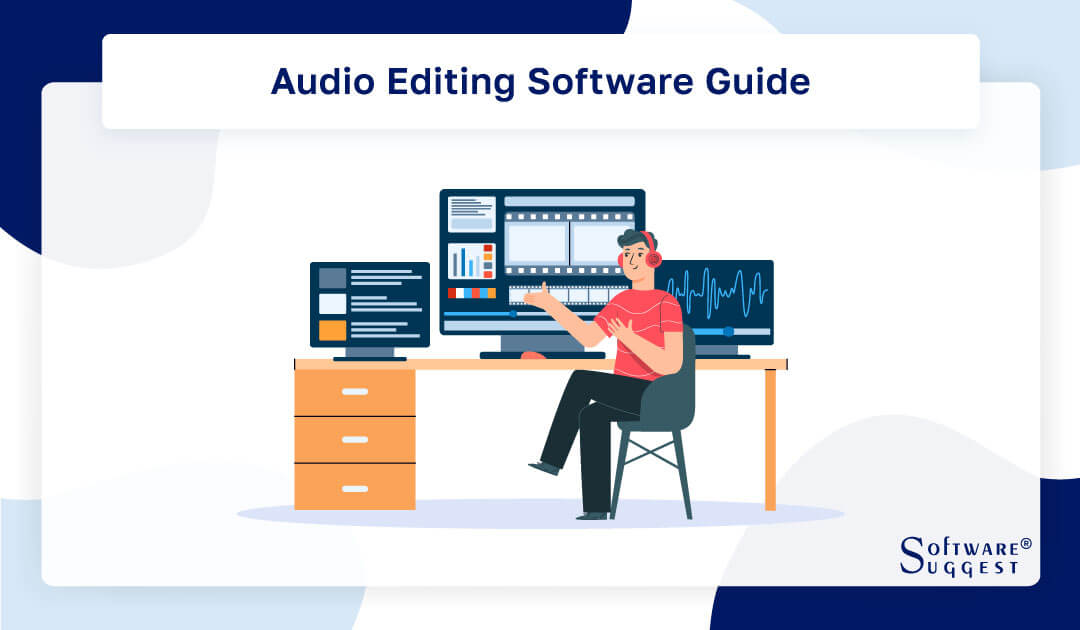
Audio Editing Software is a revolutionary solution that brings together cutting-edge technology and user-friendly interfaces, enabling users of all skill levels to achieve professional-grade results. Whether you're a seasoned audio engineer or a budding enthusiast, this software caters to your every need, giving you the freedom to shape and refine your sound to perfection.
Gone are the days of laborious tape splicing and physical mixing boards; Audio Editing Software offers a digital canvas on which you can effortlessly manipulate, cut, copy, paste, and blend audio elements with ease. From removing unwanted background noise to fine-tuning each audio track, the possibilities are limitless, limited only by your imagination.
You can edit numerous audio files at once, use a variety of real-time effects, and even add programmable audio filters to give your work a more polished appearance thanks to a bevy of capabilities at your disposal. Import and export audio files in a variety of formats without any issues, interact with others in real-time and take use of cloud-based storage for simple access to your projects from any location.
What is Audio Editing Software?
Audio editing software is developed to edit and improve audio recordings. It enables users to precisely edit, change, and creatively organize audio files. Professional sound engineers, musicians, and non-technical individuals alike can use these software applications to edit audio for their own projects.
With the use of audio editing software, users can trim, copy, and paste audio clips as well as add various sound effects like reverb and equalization, change volume settings, and remove distracting background noise. Pitch and tempo manipulation, spectrum editing, and multi-track capability for intricate audio projects are examples of advanced functionality.
The software often provides a user-friendly interface that displays the audio waveform, making it easier to visualize and edit the audio content. Audio editing software has become essential in the modern digital age, empowering individuals and professionals alike to create high-quality audio content for music production, podcasting, video editing, and other creative endeavors.
What Does Audio Editing Software Do?
A flexible tool, audio editing software can be used to modify and improve audio recordings in a number of ways. Its main objective is to give users the ability to precisely and flexibly edit and alter audio files. For simple editing operations, users can cut, copy, and paste audio fragments to reorder or eliminate particular parts. To balance audio components and get rid of unpleasant sounds or background noise, they can also change volume levels.
Additionally, audio editing software provides a range of effects and filters that users can apply to alter the sound's characteristics. These effects may include reverb, echo, equalization, compression, and more, enabling users to create unique and polished audio tracks. For more advanced users, the software often supports pitch and tempo manipulation, enabling them to change the key or speed of the audio without affecting its overall quality.
Additionally, multi-track editing is supported by audio editing software, allowing users to work with many audio sources at once. This function is very helpful for podcast and music producers who need to layer several sounds or voices to generate a well-rounded final product.
The capability of audio editing software to show audio waveforms is a crucial additional feature. This display makes it simpler to accurately edit audio by assisting users in precisely locating specified audio segments.
Overall, audio editing software for PC empowers individuals and professionals alike to craft high-quality audio content for a wide range of applications, such as music production, podcasting, audiobook creation, video editing, and much more. Its user-friendly interface and powerful features make it an essential tool in the modern digital age for anyone involved in audio-related projects.
Who Uses Music Editing Software?
Audio editing software has become an indispensable tool in the world of audio production, catering to a diverse group of users. Whether it's crafting professional soundscapes or indulging in creative experimentation, these software applications offer a wealth of possibilities. Let's explore the specific roles and benefits of music editing software for PCs that can be used by audio engineers, music producers, and amateurs.
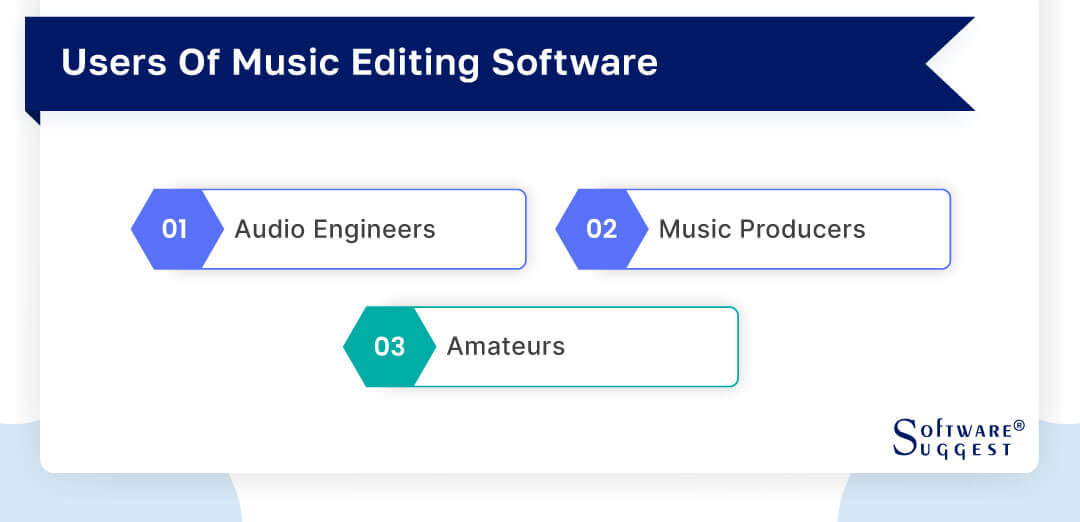
-
Audio Engineers
Audio engineers are skilled professionals responsible for recording, mixing, and mastering audio tracks to achieve the best possible sound quality. Music editing software plays a vital role in their workflow, allowing them to fine-tune recordings, edit out imperfections, and manipulate individual elements within a mix.
With precise control over audio waveforms, audio engineers can apply equalization, compression, and other effects to enhance the overall sound and create a polished result. Moreover, these software tools offer features like spectral editing and noise reduction, enabling audio engineers to address complex audio issues and deliver pristine recordings that meet the highest industry standards.
-
Music Producers
Music producers are the creative visionaries behind the entire production process, overseeing a music project's artistic direction and sound. Music editing software empowers them to bring their ideas to life, providing a vast array of tools to manipulate and arrange audio elements.
Producers can work with multiple tracks, layering instruments and vocals, adjusting timing, and experimenting with various effects to achieve the desired sonic landscape. The software's versatility allows music producers to explore different genres and styles, facilitating collaboration with artists and enabling them to add their signature touch to the final product.
-
Amateurs
Amateurs, or hobbyists, also find music editing software appealing for their creative endeavors. These individuals may be musicians, podcasters, content creators, or simply enthusiasts looking to experiment with audio. Music editing software offers an accessible entry point into the world of audio production, allowing amateurs to record and edit their music or podcasts.
The user-friendly interfaces and intuitive controls make it easier for beginners to cut, mix, and add effects to their audio without the need for extensive technical knowledge. Additionally, music editing software provides a platform for amateurs to learn and improve their skills, encouraging them to explore and express their creativity through sound.
Benefits of Best Audio Editing Software
The best audio editing software offers a myriad of benefits that significantly elevate the audio editing experience. Whether used by professionals or beginners, these powerful tools have revolutionized the way audio is manipulated and enhanced.
Let's delve into the advantages of using the finest audio editing software, including boosted productivity, improved audio normalization, enhanced audio quality, reduced background noise, and the elimination of manual audio adjustments.
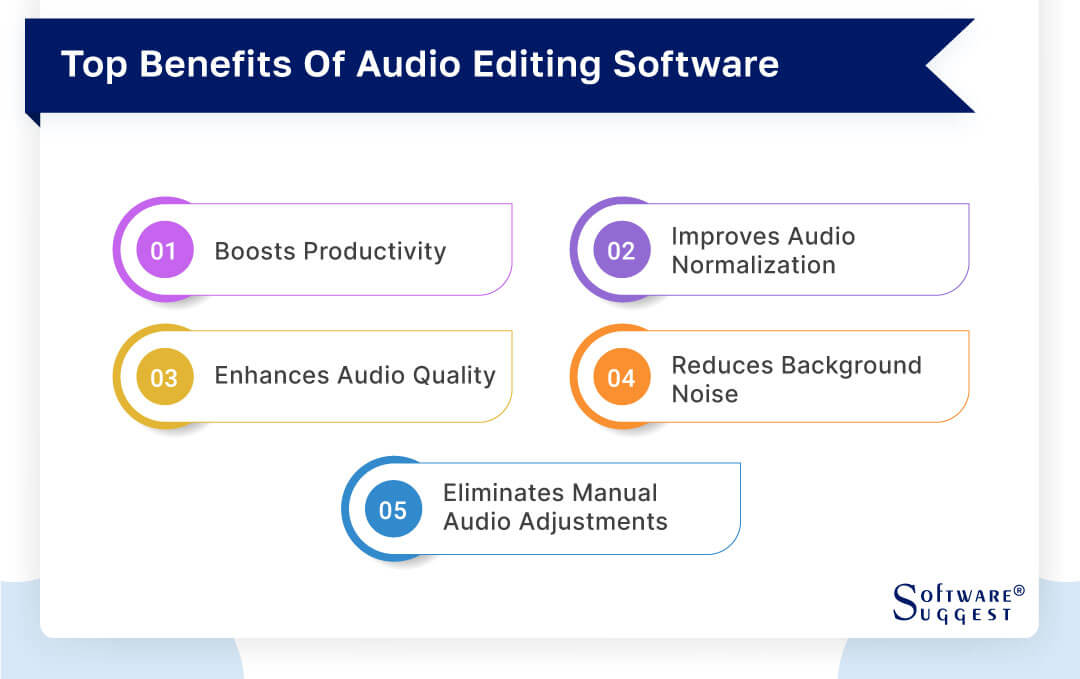
-
Boosts Productivity
Top-tier audio editing software is designed with efficiency in mind. Its intuitive interface, advanced editing features, and customizable shortcuts streamline the editing process, allowing users to work faster and more effectively. Tasks that would otherwise be time-consuming and complex can be accomplished with ease, empowering users to focus on the creative aspects of their projects. This heightened productivity not only saves time but also encourages a smoother and more enjoyable editing experience.
-
Improves Audio Normalization
One of the key benefits of using the best audio editing software is its ability to ensure consistent audio levels across different parts of a project. Audio normalization is the process of adjusting the volume of audio clips to a standardized level, avoiding sudden volume jumps and ensuring a balanced listening experience.
With precise normalization tools, users can achieve a seamless audio flow, eliminating the need to manually adjust volume levels and ultimately resulting in a more professional and polished end product.
-
Enhances Audio Quality
High-quality audio is paramount in any production, whether it's music, podcasts, videos, or other forms of content. The best audio editing software comes equipped with advanced audio processing tools that allow users to fine-tune their recordings and achieve superior sound quality. Users can apply various effects and filters to enhance the clarity, richness, and depth of audio, resulting in a more immersive and engaging experience for listeners.
-
Reduces Background Noise
Background noise can be a persistent challenge in audio recordings, especially for those done in less controlled environments. The voice audio editing software incorporates powerful noise reduction algorithms that can effectively eliminate unwanted background sounds. By identifying and reducing noise while preserving the integrity of the main audio, users can create cleaner and more professional recordings, making their content more enjoyable to listen to.
-
Eliminates Manual Audio Adjustments
In the past, audio adjustments required meticulous manual work, which could be time-consuming and error-prone. The best audio editing software automates many of these adjustments, simplifying tasks such as audio alignment, pitch correction, and timing adjustments. These automated processes not only save time but also ensure greater accuracy, resulting in seamless audio compositions and minimizing the need for tedious manual corrections.
Features of Best Music Editing Software
The best music editing software boasts an array of common features that make it a versatile and powerful tool for musicians, producers, and audio enthusiasts. These features combine to offer an all-encompassing audio editing experience, allowing users to craft, enhance, and manipulate their music with precision and creativity.
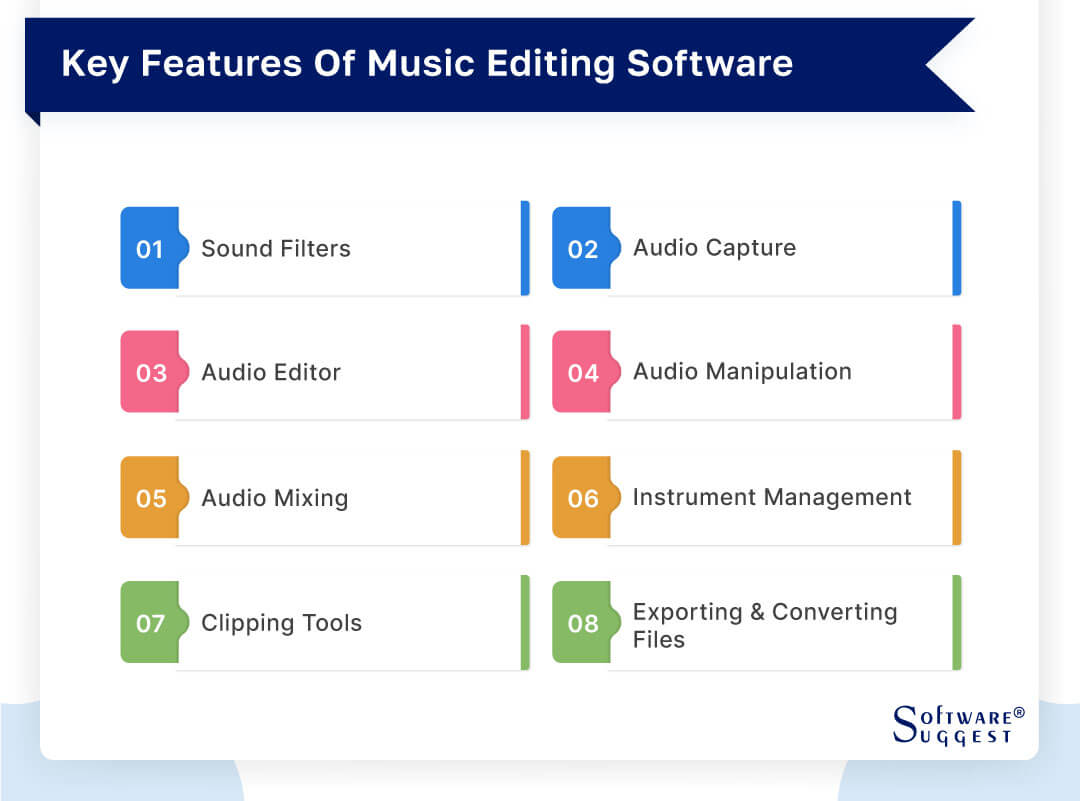
-
Sound Filters
Sound filters are an integral part of the best music editing software, providing users with a range of effects to modify and shape the audio. These filters include various equalization options, allowing users to adjust the frequency balance and tone of their music.
Additionally, users can apply effects like reverb, delay, chorus, and more to create unique and captivating soundscapes. Sound filters enable musicians and producers to add depth, texture, and character to their music, elevating it to new heights of creativity.
-
Audio Capture
The audio capture feature allows users to record audio directly within the music editing software. Whether it's capturing live performances, vocals, or any external sound source, this feature ensures seamless integration of new audio elements into the project. It eliminates the need for external recording software, streamlining the recording process and enabling users to immediately begin editing and manipulating the newly captured audio.
-
Audio Editor
At the core of any music editing software is the audio editor itself. This feature provides a comprehensive and user-friendly interface for editing audio waveforms. Users can cut, copy, paste, and arrange audio segments with precision, making it easy to create seamless transitions and tailor the composition to their desired structure. The audio editor often includes zoom and waveform visualization tools, enabling users to work with great accuracy and attention to detail.
-
Audio Manipulation
Audio manipulation features allow users to alter the audio in various ways, such as time-stretching, pitch-shifting, and quantization. This capability grants users the freedom to experiment with their music, creating unique effects and altering the tempo and pitch to fit their creative vision. With audio manipulation, musicians and producers can explore new sonic territories and push the boundaries of their compositions.
-
Audio Mixing
The audio mixing feature enables users to blend multiple audio tracks together, adjusting their volume levels and panning positions to create a cohesive and balanced mix. Music editing software provides a mixer interface that gives users precise control over each track's contribution to the final audio output. This feature is essential for achieving professional-grade mixes that accentuate individual elements while maintaining overall clarity and coherence.
-
Instrument Management
For music producers working with virtual instruments and MIDI data, instrument management is crucial. This feature allows users to organize and control their virtual instruments, MIDI tracks, and other software instruments. It ensures seamless integration and easy access to a wide array of virtual sounds, enabling users to compose and produce music with ease and efficiency.
-
Clipping Tools
Clipping tools help users manage audio levels and prevent distortion caused by excessive volume peaks. These sound editing software allow users to detect and adjust audio clips that exceed the desired amplitude range, ensuring that the audio remains clean and distortion-free throughout the editing process.
-
Exporting and Converting Files
Once the music editing process is complete, users can export their projects in various formats to suit different platforms and purposes. The best music editing software supports multiple file formats, ensuring compatibility with media players, streaming services, and other audio-related applications. Additionally, the software may include options for file conversion, allowing users to transform audio files into different formats as needed.
How to Choose the Right Sound Editing Software?
Selecting the right sound editing software is crucial for achieving professional-grade results and a seamless editing experience. With a wide range of options available, it's essential to consider various factors before making a decision.
This guide will explore four key aspects to help you choose the right audio editing software: ease of use, tracks, audio restoration tools, and compatibility. By understanding these factors, you can make an informed choice that best suits your needs and preferences.
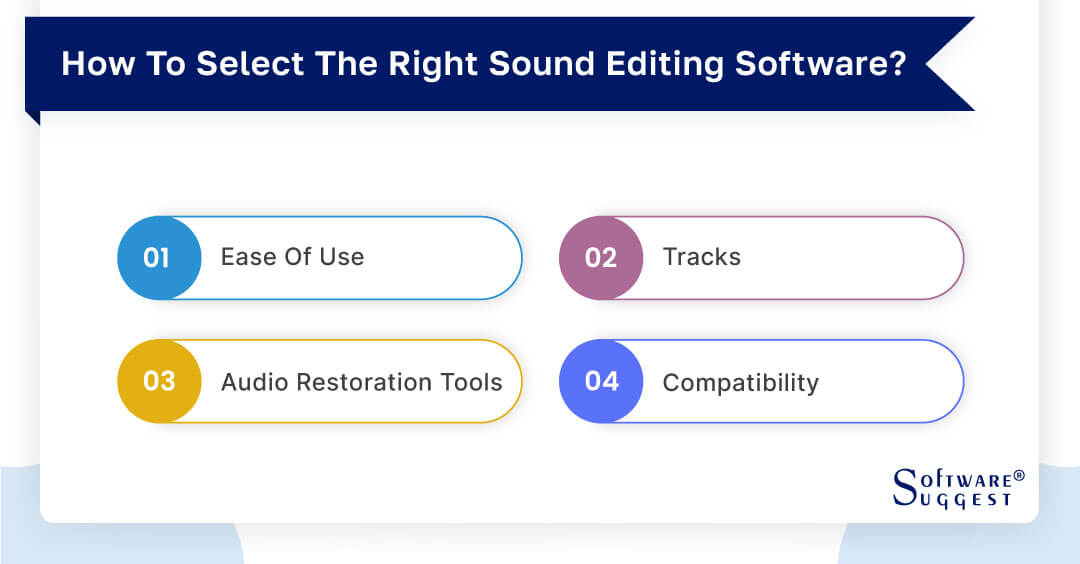
-
Ease of Use
One of the primary considerations when choosing audio editing software is its user-friendliness. An intuitive and well-designed interface can significantly impact your productivity and overall editing experience. Look for software that offers a clear and straightforward layout with easily accessible tools and controls.
-
Tracks
The number of tracks supported by the audio editing software is crucial, especially for complex projects. Consider the scale of your audio projects and the number of simultaneous tracks you might need. For professional audio engineers and music producers working on multi-layered compositions, software with support for a high number of tracks is essential.
-
Audio Restoration Tools
Audio restoration tools are valuable for improving the quality of older or poorly recorded audio. When choosing audio editing software, consider the availability and effectiveness of these tools. Look for features like noise reduction, click and pop removal, and audio enhancement tools that can help clean up and restore audio recordings.
-
Compatibility
Compatibility is a critical factor to ensure that your audio editing software works smoothly with your computer's operating system and hardware. Check the system requirements of the software to confirm that it is compatible with your computer.
Top 5 Audio Editing Software Comparison
|
Name
|
Free Trial
|
Demo
|
Pricing
|
|---|---|---|---|
|
Yes |
Yes |
Free |
|
|
7 Days |
Yes |
$20.23/month |
|
|
7 Days |
Yes |
$3.88/user/month |
|
|
90 Days |
Yes |
On Request |
|
|
30 Days |
Yes |
On Request |
Before selecting any audio editing software, it’s crucial to compare different options to find the best fit. Below is the list of 5 best audio editing software that you can check and compare.
1. Audacity

Popular free, open-source audio editing program Audacity is renowned for its adaptability and user-friendly design. It can be used by a range of users because it works with Windows, macOS, and Linux. The vast array of editing tools provided by Audacity includes cut, copy, paste, and a number of effects for audio manipulation.
Users are able to manage multiple audio sources simultaneously because it supports multi-track editing. For users who want to record and edit high-quality audio, Audacity provides sophisticated features like time-stretching and pitch-shifting, noise reduction, and spectral editing. Customers are guaranteed a dynamic and feature-rich audio editing experience because to its big user community and frequent updates.
- Multi-track editing
- Cut, copy, paste, and delete
- Effects and filters
- Spectrogram view
- Noise reduction
- Time-stretching and pitch-shifting
- Crossfade and envelope Editing
- Export and import
- Accessibility and customization
- Plug-in support
- The software has ease of recording.
- The software provides simple steps to increase the volume of the recording.
- The software easily saves and exports the audio file.
- There is recording & re-recording directly in the program.
- It's not always easy to replace audio sections in the system.
- Adding more instructions as it's a simple program but users may need an external guide to get started.
- The software provides an automatic filter for background noise.
- The software offers speech to text captioning option.
Audacity Pricing
- Free
2. Adobe Audition
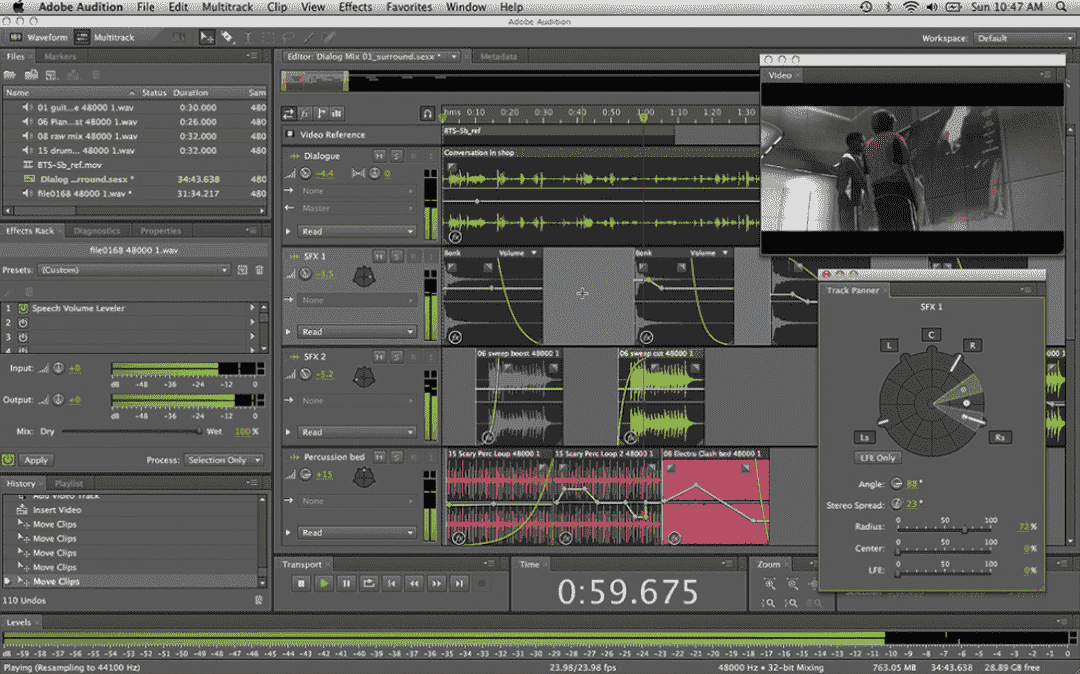
A professional-level audio editing software for PC called Adobe Audition was created by Adobe Inc. It is favored by audio professionals, musicians, and content creators due to its powerful capabilities and adaptability. Adobe Audition enables users to carry out accurate audio editing, restoration, and mixing operations thanks to an intuitive user interface and a wide range of editing tools.
Spectral editing, multi-track capabilities, real-time audio effects, and seamless connection with other Adobe Creative Cloud products are some of its advanced features. Adobe Audition offers a robust framework for creating and refining high-quality audio content with great precision and efficiency, whether it is for music editing, podcast production, or audio post-production for media.
- Multitrack editing
- Spectral frequency editing
- Real-time effects
- Automatic speech alignment
- Essential sound panel
- Time remapping
- Batch processing
- Surround sound editing
- Integration with Adobe Creative Cloud
- Extensive format support
- The clean program removes pops and other noises from recordings.
- Improve the way you record team meetings.
- The internal database of calls and podcasts is managed by the program.
- Sync the audio with the client presentations that the team often creates.
- The software has a lot of unnecessary settings.
- Interfacing with soundboards could be simpler.
- The ability to monitor single-track recordings would be great.
Adobe Audition Pricing
- Plan: $20.23/month
3. WavePad
 0
0
WavePad is a user-friendly and feature-rich audio editing software designed for both beginners and experienced users. WavePad, created by NCH Software, provides a variety of tools for modifying, improving, and editing audio files. Users may easily cut, copy, paste, and add different effects to audio snippets thanks to the program's user-friendly interface.
Because the program allows for multi-track editing, it is appropriate for tasks that call for handling many audio sources at once. WavePad meets a wide range of audio editing demands, including music production, podcasting, and voiceover work, with capabilities including noise reduction, audio restoration, and real-time effects. Anyone looking for an extensive audio editing solution without losing usability and usefulness should consider it because of its cost and adaptability.
- Multi-track editing
- Effects and filters
- Noise reduction and restoration
- Real-time effects preview
- Audio spectrum analysis
- Audio bookmarking and markers
- Audio format support
- Batch processing
- Wavepad is an easy-to-use sound recording and editing tool.
- The sample rate capability is very great, the team can actually convert to even a lesser bit to save storage.
- Wavepad also has available plugins from their market and they are cheaper.
- Wavepad has fewer resources than other audio edition software.
- Noise reduction is not that good even in the paid version.
WavePad Pricing
- WavePad pricing varies from $3.88 per user per month to $69.95 per user per year.
- WavePad's free audio editor is available for free for non-commercial use.
- The WavePad Pricing for the various segments is as follows: Standard Edition - $29.99/user/year.
4. Logic Pro X

Logic Pro X is a cutting-edge audio editing software for PC, renowned for its professional-grade capabilities and intuitive interface. The program gives users access to a wide range of plugins, virtual instruments, and audio effects, enabling them to create music with enticing textures and appealing sounds. Smooth productivity and effective editing are made possible by the software's user-friendly features and clean design, which are accessible to both seasoned pros and novices. It is perfect for complicated audio projects due to its multi-track editing features, which let users work on numerous audio layers at once.
- Professional-Grade Virtual Instruments
- Multi-Track Editing
- Smart Tempo and Flex Time
- MIDI Editing
- Audio Recording
- Smart Controls and Automation
- Drummer and Drum Kit Designer
- Audio Effects and Plugins
- Logic Remote
- Flex Pitch and Flex Time
- The software is simple, intuitive user interface.
- The software provides a wide range of compatible third-party plugins.
- It has excellent built-in VSTs.
- A vast library of virtual instruments and effects is included in the purchase.
- Workflow is great for audio editing but not so great for composition.
- Some built-in plugins are old and need a refresh.
- The software has frequent crashes.
Logic Pro X Pricing
- On Request
5. FL Studio
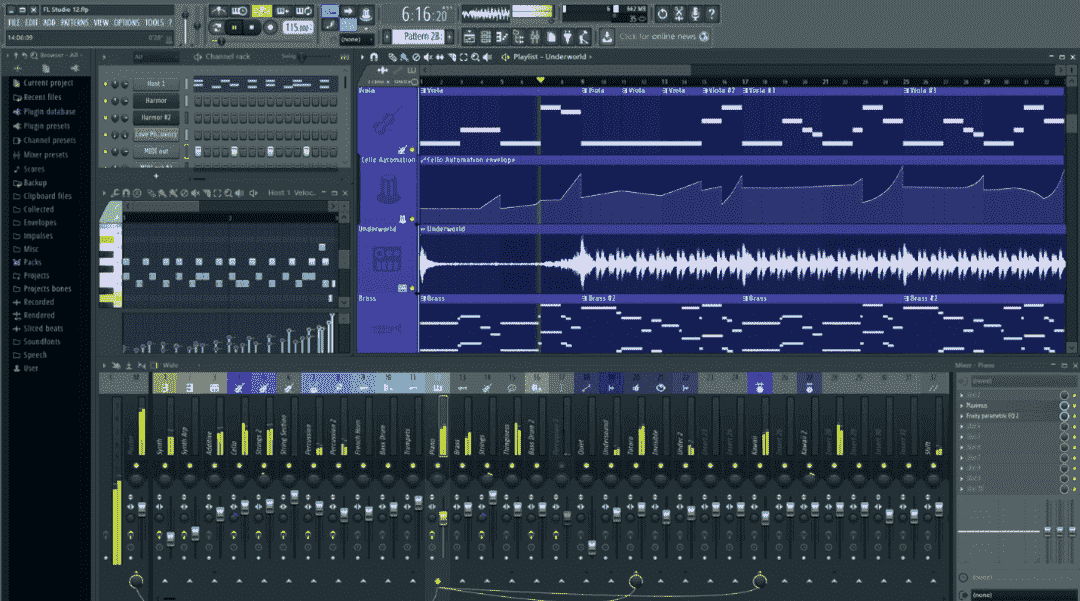
The well-known FL Studio digital audio workstation (DAW), created by Image-Line, is a robust and adaptable program for music creation and audio manipulation. Users may easily produce, edit, and mix audio content with FL Studio's user-friendly interface and cutting-edge functionality. The software is appropriate for a variety of musical genres and styles because it provides a large selection of virtual instruments, audio effects, and MIDI capabilities.
It's step sequencer and piano roll make it simple to compose music, while its sophisticated mixing and automation tools provide users with fine-grained control over audio recordings. Due to its creative possibilities and adaptability when managing audio projects, FL Studio is a top choice for anyone looking for an all-encompassing music production, DJ, and electronic music platform.
- Step Sequencer and Piano Roll
- Virtual Instruments
- Audio Recording and Editing
- Mixer and Effects
- Automation and MIDI Control
- Time Signature and Tempo Changes
- Support for VST Plugins
- Mixer Track Groups
- Collaboration and Export Options
- Mobile Compatibility
- FL Studio is a comprehensive digital audio workstation that includes all of the audio tools needed by producers as well as engineers for recording and mixing.
- The use of audio samples and audio VST plugins can be used to create musical arrangements.
- The program may record audio when an audio interface is being used, enabling you to record vocals or musical instruments straight over an audio connection.
- Once your music is finished, you can mix it in the mixer utilizing effect VST plugins like equalizers and compressors to improve the sound and make sure the various components don't conflict.
- Although FL Studio does have some built-in VST plugins, there are better 3rd party plugins that need to purchase if the user would like to unlock the full potential of FL Studio.
- Has a steep learning curve and takes a lot of time to learn and to familiarize with.
FL Studio Pricing
- On Request
Software Related to Audio Editing Software
In the world of audio production and content creation, various software applications complement and extend the capabilities of audio editing software. These sound editing software cater to specific needs, allowing users to create engaging multimedia experiences. Below are the essential software related to audio editing software.
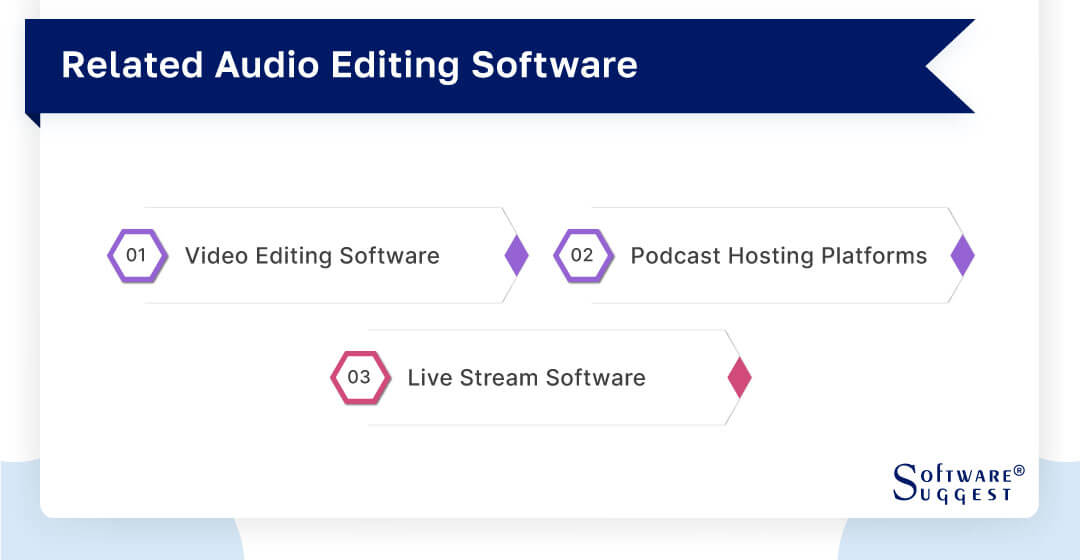
-
Video Editing Software
Video editing software is a crucial companion to audio editing software, especially for projects involving synchronized audio and video content. Most video editing software allows users to combine audio tracks with video footage, enabling the creation of multimedia presentations, music videos, films, and more.
-
Podcast Hosting Platforms
Podcasts have gained immense popularity as a medium for sharing audio content, and podcast hosting platforms play a significant role in their distribution. These platforms provide storage space and bandwidth to host audio files, making them accessible to listeners via podcast directories and platforms like Apple Podcasts, Spotify, and Google Podcasts.
-
Live Stream Software
Live stream software enables real-time broadcasting of audio and video content to audiences around the globe. Musicians, podcasters, and content creators use live stream software to engage with their audience in real-time, hosting live events, concerts, Q&A sessions, and more.
Challenges with Music Editing Software
Audio editing software has revolutionized the way we create and manipulate audio content, offering powerful tools for musicians, producers, and content creators. However, like any technology, music editing software also presents its share of challenges.
This section will explore three common challenges users may face with music editing software, such as matching audio and video clips, exporting issues, and hardware limitations. Understanding these challenges can help users better navigate the editing process and find effective solutions.

-
Matching Audio and Video Clips
One of the significant challenges when working with music editing software is synchronizing audio with video clips. This is especially relevant for projects involving multimedia content, such as music videos, film scoring, or video presentations.
When audio and video are not perfectly aligned, it can lead to issues like lip-sync problems or audio cues not matching visual events. Achieving precise synchronization requires careful attention to detail and precise editing skills. Additionally, factors like frame rates, sample rates, and timecodes must be considered to ensure seamless integration between audio and video elements.
-
Exporting Issues
Exporting audio projects from music editing software can sometimes present challenges. Users may encounter problems related to file formats, audio quality, or compatibility with other software and platforms. Exporting audio files with incorrect settings or suboptimal compression can lead to reduced audio quality or compatibility issues with media players or streaming platforms.
-
Hardware Limitations
Music editing software can be resource-intensive, demanding significant processing power and memory from the computer hardware. Users working on large projects with numerous tracks and complex effects may encounter performance issues, such as lagging, freezing, or crashes.
This challenge is particularly prevalent for users with less powerful computers or limited RAM. To overcome hardware limitations, users can consider optimizing their software settings, using hardware acceleration when available, and investing in more robust computer hardware to handle intensive editing tasks effectively.
Latest Trends in Audio Editing Software
As technology continues to advance, the landscape of audio editing software is constantly evolving to meet the demands of modern creators and producers. In this section, we will explore some of the latest trends in audio editing software that are shaping the way audio content is created and manipulated.

-
AI-Powered Tools
The field of audio editing software has seen considerable advancements in artificial intelligence (AI). With intelligent capabilities that may automate tedious processes and improve the editing process overall, AI-powered tools are transforming the editing process. These programs may analyze audio files automatically, distinguish between various components, and provide suitable modifications, such as vocal tuning, noise reduction, and audio improvement.
The process of source separation, sometimes referred to as stem extraction, in which audio sources are extracted from complex audio mixtures can also be aided by AI algorithms. Users of audio editing software are given the ability to make edits more quickly and accurately while also having more creative options available to them.
-
Mobile Editing
With the widespread adoption of smartphones and tablets, mobile editing solutions have gained immense popularity. Audio editing software developers are increasingly focusing on creating mobile apps that offer powerful editing capabilities on portable devices. Mobile editing enables creators to edit audio on-the-go, providing flexibility and convenience for musicians, podcasters, and content creators who need to work in various environments.
These apps often include user-friendly interfaces and essential editing features, making them accessible to both beginners and experienced users. The ability to edit audio directly on mobile devices has democratized audio production and opened up new avenues for creativity.
-
Integration with DAWs and Plugins
Audio editing software is now being designed with seamless integration into Digital Audio Workstations (DAWs) and plugin ecosystems. DAWs are essential platforms for music production and audio recording, while plugins add additional effects, instruments, and functionalities to enhance audio projects.
Audio editing software that integrates smoothly with DAWs allows users to transition between editing and music production seamlessly. It enables users to export edited audio tracks directly to their DAW for further processing and arrangement, streamlining the workflow and ensuring a cohesive production process. Furthermore, some audio editing software now acts as standalone plugins, enriching the range of tools available to DAW users.
Conclusion
In conclusion, audio editing software stands as a cornerstone in the realm of modern audio production, empowering users with a wide array of tools and features to shape, enhance, and manipulate sound. From audio engineers and music producers seeking professional-grade tools to amateurs exploring their creative passions, the accessibility and versatility of these software applications have democratized the art of audio creation.
As technology continues to advance, we witness the emergence of AI-powered tools, the rise of mobile editing solutions, and seamless integration with DAWs and plugins, offering unprecedented possibilities for audio editing and production.
The future of audio editing software promises even greater innovation, opening new frontiers of creativity and expression for those who endeavor to shape the auditory world. Whether it's crafting music, perfecting podcasts, or creating captivating audio content, audio editing software will remain an essential companion for anyone seeking to make their mark in the realm of sound.
FAQs
The cost of audio editing software varies widely, depending on the features, functionality, and intended user base. There are free options available that provide basic editing capabilities suitable for beginners and casual users. On the other hand, professional-grade audio editing software, equipped with advanced tools and capabilities, can range from around $100 to several hundred dollars. Overall, users can find audio editing software that fits their budget and requirements, making it accessible to a wide range of creators and producers.
Windows 10 does not come with a built-in, standalone audio editor as part of its default applications. However, it does include audio editing tools called "Sound Recorder." Sound Recorder allows users to make simple audio recordings and perform basic edits, such as trimming the beginning and end of a recording. While it can be useful for simple tasks, it lacks the advanced features and functionalities of dedicated audio editing software. Users seeking more robust audio editing capabilities may need to explore third-party audio editing software options available for Windows 10, many of which offer a wide range of professional-grade audio editing and manipulation tools.
You can edit audio for free using various software options available online. Some popular free audio editing software includes Audacity, WavePad, and Ocenaudio. These programs offer a wide range of editing tools, such as cutting, copying, pasting, and applying various audio effects. With these free audio editing software, you can trim audio, remove background noise, adjust volume levels, and even work with multiple tracks.
They often support various audio formats, making them suitable for different projects, whether it's creating music, editing podcasts, or enhancing audio for videos. These free tools provide a great starting point for anyone looking to edit audio without the need for a financial investment.
The two primary types of audio editing are destructive editing and non-destructive editing. Destructive editing involves making permanent changes to the original audio file, altering the waveform directly. When performing destructive editing, any modifications made cannot be undone, and the original data is lost.
The time it takes for audio editing can vary significantly depending on several factors. The complexity and length of the audio content, the extent of the edits needed, the skill level of the editor, and the tools used all play a role in determining the editing duration. Simple tasks like trimming or basic volume adjustments on short audio clips may take just a few minutes, while more complex projects with multiple tracks, intricate effects, and detailed audio restoration can take hours or even days to complete.





















